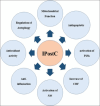Neuroprotective effect of ischemic postconditioning against hyperperfusion and its mechanisms of neuroprotection
- PMID: 39239075
- PMCID: PMC11376715
- DOI: 10.4103/jrms.jrms_341_22
Neuroprotective effect of ischemic postconditioning against hyperperfusion and its mechanisms of neuroprotection
Abstract
Background: In recent years, stroke and ischemia-reperfusion injury has motivated researchers to find new ways to reduce the complications. Although reperfusion is essential for brain survival, it is like a double-edged sword that may cause further damage to the brain. Ischemic postconditioning (IPostC) refers to the control of blood flow in postischemia-reperfusion that can reduce ischemia-reperfusion injuries.
Materials and methods: Articles were collected by searching for the terms: Ischemic postconditioning and neuroprotective and ischemic postconditioning and hyperperfusion. Suitable articles were collected from electronic databases, including ISI Web of Knowledge, Medline/PubMed, ScienceDirect, Embase, Scopus, Biological Abstract, Chemical Abstract, and Google Scholar.
Results: New investigations show that IPostC has protection against hyperperfusion by reducing the amount of blood flow during reperfusion and thus reducing infarction volume, preventing the blood-brain barrier damage, and reducing the rate of apoptosis through the activation of innate protective systems. Numerous mechanisms have been suggested for IPostC, which include reduction of free radical production, apoptosis, inflammatory factors, and activation of endogenous protective pathways.
Conclusion: It seems that postconditioning can prevent damage to the brain by reducing the flow and blood pressure caused by hyperperfusion. It can protect the brain against damages such as stroke and hyperperfusion by activating various endogenous protection systems. In the present review article, we tried to evaluate both useful aspects of IPostC, neuroprotective effects, and fight against hyperperfusion.
Keywords: Ischemic postconditioning; neuroprotective; reperfusion injury.
Copyright: © 2024 Journal of Research in Medical Sciences.
Conflict of interest statement
There are no conflicts of interest.
Figures





Similar articles
-
Ischemic postconditioning relieves cerebral ischemia and reperfusion injury through activating T-LAK cell-originated protein kinase/protein kinase B pathway in rats.Stroke. 2014 Aug;45(8):2417-24. doi: 10.1161/STROKEAHA.114.006135. Epub 2014 Jul 10. Stroke. 2014. PMID: 25013016
-
Diverse Ischemic Postconditioning Protocols Affect the Infarction Size in Focal Ischemic Stroke.J Cerebrovasc Endovasc Neurosurg. 2018 Sep;20(3):159-167. doi: 10.7461/jcen.2018.20.3.159. Epub 2018 Sep 30. J Cerebrovasc Endovasc Neurosurg. 2018. PMID: 30397587 Free PMC article.
-
Advances in intervention methods and brain protection mechanisms of in situ and remote ischemic postconditioning.Metab Brain Dis. 2021 Jan;36(1):53-65. doi: 10.1007/s11011-020-00562-x. Epub 2020 Oct 12. Metab Brain Dis. 2021. PMID: 33044640 Review.
-
Safety and Tolerability of Direct Ischemic Postconditioning Following Thrombectomy for Acute Ischemic Stroke.Stroke. 2023 Sep;54(9):2442-2445. doi: 10.1161/STROKEAHA.123.044060. Epub 2023 Jul 27. Stroke. 2023. PMID: 37497674
-
The application and neuroprotective mechanisms of cerebral ischemic post-conditioning: A review.Brain Res Bull. 2017 May;131:39-46. doi: 10.1016/j.brainresbull.2017.03.002. Epub 2017 Mar 8. Brain Res Bull. 2017. PMID: 28284901 Review.
Cited by
-
Research progress on remote ischemic conditioning for improving prognosis of patients with acute ischemic stroke.Biochem Biophys Rep. 2025 Jul 30;43:102184. doi: 10.1016/j.bbrep.2025.102184. eCollection 2025 Sep. Biochem Biophys Rep. 2025. PMID: 40791818 Free PMC article. Review.
References
-
- Sundt TM, Jr., Sharbrough FW, Piepgras DG, Kearns T, Messick JM, Jr., O’fallon WM. Correlation of cerebral blood flow and electroencephalographic changes during carotid endarterectomy, with results of surgery and hemodynamics of cerebral ischemia. Surv Anesthesiol. 1982;26:200–1. - PubMed
-
- Esmaeeli-Nadimi A, Kennedy D, Allahtavakoli M. Opening the window: Ischemic postconditioning reduces the hyperemic response of delayed tissue plasminogen activator and extends its therapeutic time window in an embolic stroke model. Eur J Pharmacol. 2015;764:55–62. - PubMed
-
- Mandalaneni K, Rayi A, Jillella DV. StatPearls. St. Petersburg, Florida, United States: StatPearls Publishing; 2022. Stroke reperfusion injury. - PubMed
-
- Bernstein DL, Zuluaga-Ramirez V, Gajghate S, Reichenbach NL, Polyak B, Persidsky Y, et al. miR-98 reduces endothelial dysfunction by protecting blood-brain barrier (BBB) and improves neurological outcomes in mouse ischemia/reperfusion stroke model. J Cereb Blood Flow Metab. 2020;40:1953–65. - PMC - PubMed
Publication types
LinkOut - more resources
Full Text Sources
